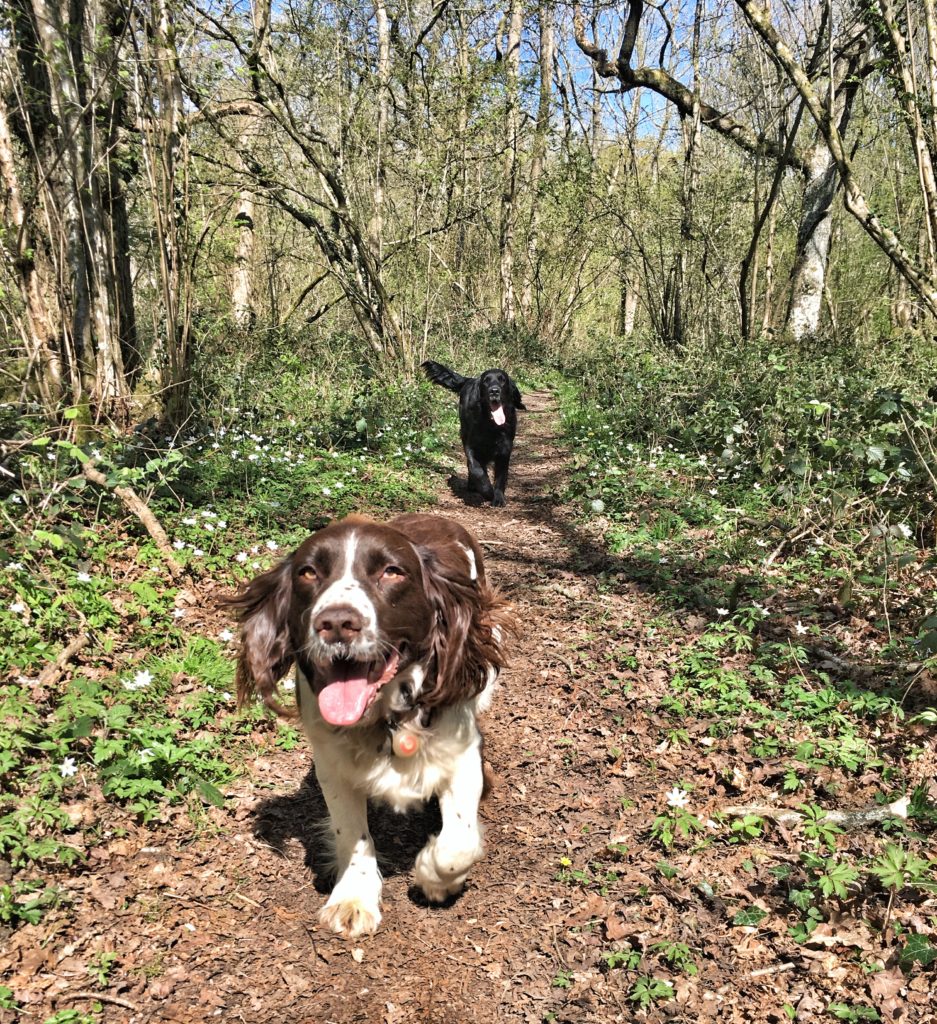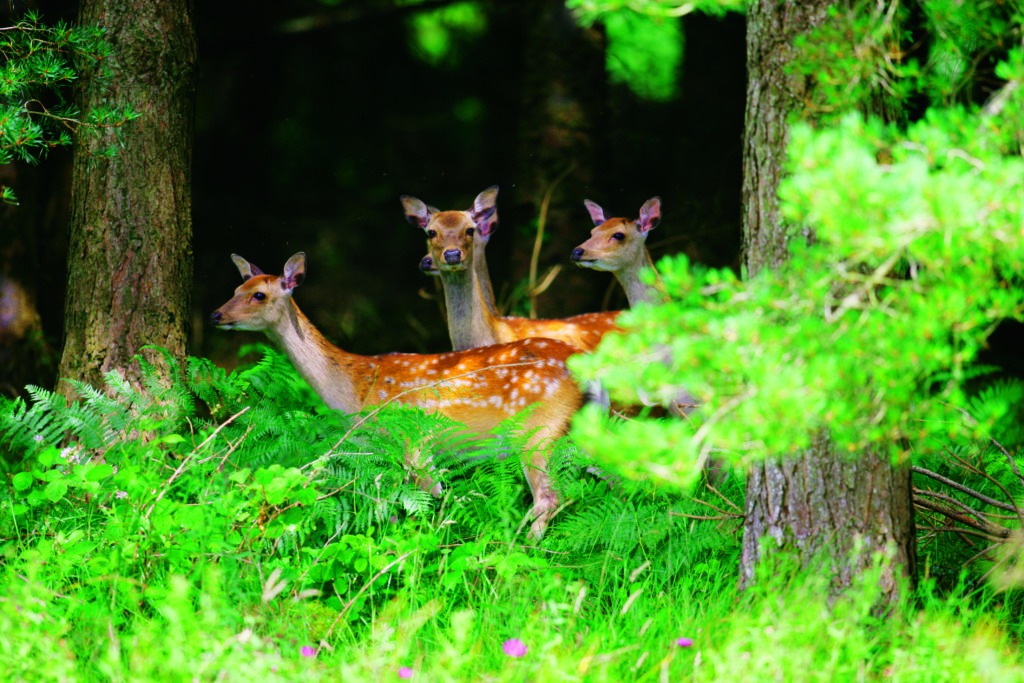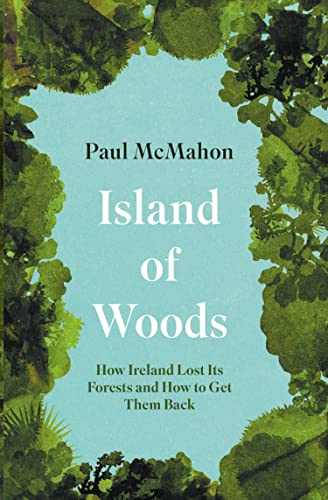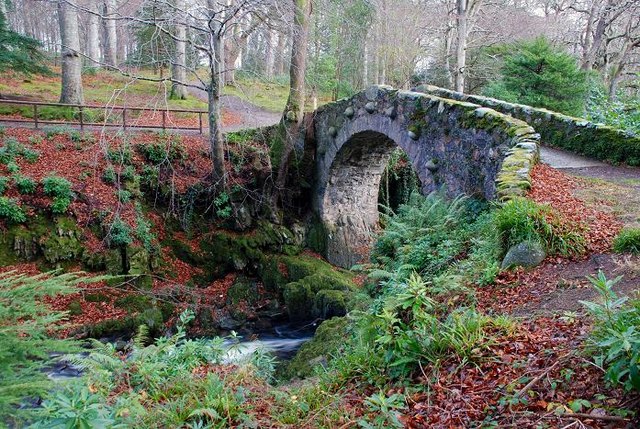Island of Woods by Paul McMahon examines the complex situation of Ireland’s forests. The book is sub-titled How Ireland Lost Its Forests and How to Get Them Back — the author sets out how this can be accomplished.
 BARKING UP THE RIGHT TREE - Dogs in an ancient woodland
BARKING UP THE RIGHT TREE - Dogs in an ancient woodlandFORESTRY in Ireland has seldom, if ever, caused so much controversy.
According to research by Coillte, the Irish state-owned forestry agency, only 11 per cent of western peatland forests would be able to deliver wood production that is economically and environmentally viable.
But across Ireland, north and south, 346,000 hectares of forest are found growing on deep peat. If the Coillte assessment is accurate, it means there are more than 300,000 hectares that cannot be harvested as things stand. “To put it bluntly, the dirty secret of Irish forestry is that around one-third of the forests are no good. The island is full of zombie forests that shouldn’t be there in the first place but can’t be cut down because it would cost too much or damage the environment. No one is quite sure what to do with them.” This is one of the many conclusions in Paul McMahon’s book Island of Woods: How Ireland Lost Its Forests and How to Get Them Back.
Forestry is the subject of demonstrations outside Leinster House, of angry calls to radio shows, of protests and petitions, letters to newspapers.
Over the last century the area of Irish woodland has increased tenfold, mostly through the planting of imported, fast-growing coniferous species: government policy is to plant more trees to supply industry and to tackle climate change, both urgent priorities.
Trees are ideal ‘carbon fixers’, that is they remove carbon dioxide (CO2) from the atmosphere, They absorb CO2 from the environment and combine it with water through photosynthesis — the carbon is then locked up for centuries. They are thus prime removers of ‘greenhouse gases’, a potent force in combatting climate change. And it matters little what type of tree — it can be a dreaded Leylandii, the suburban hedge tree, or an ancient native oak. All do the same job in removing carbon from the atmosphere.
But it is a complex issue. Not all tree planting is automatically ‘good’; and it is certainly not universally popular.
In areas where planting is planned, there has been a backlash from farmers, local communities, environmentalists and EU regulators. When Coillte announced they wanted to add to the Sitka spruce plantations on the hillside of Cabinteely Park, which leads into the Dublin and Wicklow Mountains, protests began almost immediately the plans were made public. As Paul McMahon puts it: “Sitka spruce is a fast-growing conifer that comes from the Pacific coast of North America. The plantations form large, angular blocks of dark green that never lose their colour, even in winter. They have grown so tall that they have altered the horizon. Where the plantations start and end, there is an abrupt step in the skyline, as if a giant had laid down blocks on top of the mountains. Where groups of trees have been felled within the blocks, there is a gap in the silhouette, like a missing tooth in a boxer’s grimace.”
 Forest wildlife in Co. Fermanagh (Northern Ireland Tourism image)
Forest wildlife in Co. Fermanagh (Northern Ireland Tourism image)If you’ve travelled anywhere in Ireland, north or south, you'll have seen plantations of Sitka spruce. And you will know that they are dense plantations almost impossible to walk through without the aid of a chainsaw. They may be storing carbon, but they are not pretty, nor are they particularly environmentally friendly aside from their climate change duties.
You may think that’s enough — saving the planet is surely more important than whether you can go for a dander in the hills? Many people in Cabinteely disagreed. Protests, campaigns, angry letters to the newspapers — Coillte was forced to back down, change its plans and embrace a different kind of forestry.
 So how did we get here? Island of Woods provides some of the answers, taking a sweeping historical view, tracing the history of Irish forests over the last 10,000 years. Paul McMahon examines the state of Irish forestry today and sketches a way forward for our woods that balances commercial, environmental and social goals – a vision of a different type of forestry that could transform the Irish landscape and re-establish a genuine tree culture in the country.
So how did we get here? Island of Woods provides some of the answers, taking a sweeping historical view, tracing the history of Irish forests over the last 10,000 years. Paul McMahon examines the state of Irish forestry today and sketches a way forward for our woods that balances commercial, environmental and social goals – a vision of a different type of forestry that could transform the Irish landscape and re-establish a genuine tree culture in the country.
This comprehensive and engaging overview of the history of Irish forestry relates historical events to present-day concerns and controversies, drawing out general themes that echo throughout the centuries.
History, of course, plays a large part in the appearance of Ireland. Paul McMahon writes: “By the beginning of the twentieth century, following centuries of woodland clearance, the island was practically treeless again. Only 1 per cent of Ireland was covered in woodland, by far the lowest amount of any European country. How did this happen? We Irish like to think of ourselves as tree-lovers. We have a romantic notion of a Celtic sylvan past, something that lives on in a tradition of sacred trees dotted around the countryside. The corollary is that we tend to blame foreigners for destroying our arboreal heritage. The popular view is that it is all the fault of Queen Elizabeth or Oliver Cromwell, collateral damage in the bloody English conquest of Ireland 500 years.”
So is this true? Paul McMahon teases out the answers, and his conclusions might surprise you.
The author begins his survey from the end of the ice age, or the Last Glacial Maximum as scientists call it. The first tree to colonise our island after the ice receded was the birch, the ultimate pioneer species. It can be counted on to be first on scene. Even if it’s told, in botanical terms of course, “nothing to see here”, it persists. It produces lots of tiny winged seeds that disperse on the wind, and it usually takes hold.
Birch was followed by hazel. According McMahon “there are patches of hazel woodland in the Burren in County Clare that provide a glimpse of what the landscape looked like in the postglacial era”.
Thereafter in Island of Trees follows a meticulous description of what our forebears found when they fetched up in Ireland, from exactly where, we’re not sure. But when they landed some 9,000 to 10,000 years ago they would have found a densely afforested island.
How we went from that to the situation today, with controversy and counter-claims of the merits and demerits of various kinds of forestry makes this a fascinating book. It encompasses everything from climate change to Ireland’s first colonisers, and from the politics which divided the land in so many ways, to the economics that have flowed from this.
 Foley's Bridge, Tollymore Forest, Co. Down, a former estate of the Anglo-Irish ascendancy
Foley's Bridge, Tollymore Forest, Co. Down, a former estate of the Anglo-Irish ascendancyArboreal and horticultural influencers
McMahon focuses on the Anglo-Irish Ascendancy who emerged in firm control of the land. They deserve some credit for their years of planting and importing species they’d robbed from across the world: sycamore, beech and horse chestnut. Some 7,000 big houses had well-wooded demesnes. The Ascendancy became protectors of woodland but farmers saw land planted with trees that could have fed families and forestry became something to be despised. McMahon writes: “The two Irelands had very different attitudes towards trees. There was a curious role reversal from the earlier period of conquest and colonisation. Before, English planters saw it as their civilising duty to clear forest ‘wastes’ wherever they could. Now, they became protectors of woodlands and proud creators of tree plantations. Then, Gaelic bards lamented the destruction of sacred trees and sylvan refuges. Now, the Irish peasant farmer saw forestry as an alien import and a competitor for precious land. Trees became loaded with political and cultural meaning, in a uniquely Irish way. So long as the Protestant Big Houses held a firm grip on the land, there would be a brief increase in forest cover in Ireland. But when the old order finally crumbled, and small farmers took back ownership of the land, trees came tumbling down again.”

